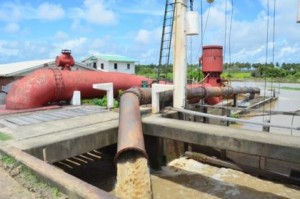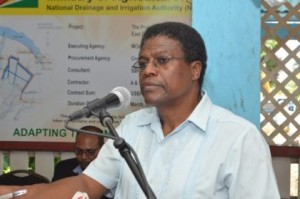The National Drainage and Irrigation Authority (NDIA) is now in a state of readiness to respond to any eventuality which may arise in the next rainy season.
Chief Executive Officer, acting, of the NDIA, Frederick Flatts told the Government Information Agency (GINA) the authority’s capacity of equipment and tools is in a much improved state and can respond adequately should the need arise.
“… we have about 90% of our pumps working all the time, available. In terms of our excavators I would say, last year July when I took over this office we had about 47% of our excavators and bulldozers working. Right now we have about 70% (working),” Flatts said.
According to Flatts, the authority’s expenditure and execution of capital and other projects for the year is on schedule, and will be completed in time for the end of the current fiscal year.
“The budget for capital works is about $1.4 Million and we have spent about 30%, however, within weeks our expenditure will be somewhere in the region of 70%. We have a lot of works that are being done and so we hope to catch up. In terms of current budget it is about $1.7 Billion and we are on track with that. We have spent about 75% of that,” the CEO, acting explained.

A section of the East Demerara Water Conservancy (EDWC), one of the water management facilities under the ambit of the NDIA
Despite several unexpected situations, Flatts said much has been achieved using the capital and current provisions.
“In terms of achievements I would say a lot has been done. At the beginning of the year we had to deal with El Nino. I would say we came out in flying colours. We were able to supply farmers with water during El Nino period and that’s from Pomeroon going right down to Crabwood creek. It involved a lot of work. We had to move our mobile pumps from pumping into the ocean and river and gather them into the backlands to supply water to the farmers. Also very importantly we were able to supply surface water to Georgetown for potable purposes. We supply 60% of Georgetown’s water so that was an important function during that period,” Flatts noted.
Flatts added that, during the rainy period – May, June and July into August, “We did very well. We had some challenges. In Region Five the residential areas there were flooding. That’s really the work of the Neighbourhood Democratic Council (NDC), but we got into the act and we deployed some mobile pumps into the area. We deployed a pontoon with two excavators to help clean the outfall channel. We have also put things in place so there can be no occurrence. We now have both pumps at the Trafalgar pump station working.”

One of the NDIA pumps helping to drain flood water at the Trafalgar outfall channel, West Berbice, earlier in the year
Highlighting the works to relieve communities and help farmers return to productively utilising land, Flatts pointed to works done in Mocha, East Bank Demerara.
“We have done significant work in Mocha. Mocha was a swamp. I’m talking about the agricultural area. This has now been transformed. We still have more work to do, but we will continue to do that until people in the area are able to get back to the farm lands. We have done work to the channels in the agricultural area, the number three canal. We have cleared that and the channels going to the farm sluice, as well as Little Diamond. We have rehabilitated the Little Diamond sluice so a lot has been done across the country,” the CEO pointed out.
The NDIA is the agency tasked with managing the drainage and irrigation systems countrywide. It is an agency of the Ministry of Agriculture and collaborates with all Local Democratic Organs in the execution of its mandate.






